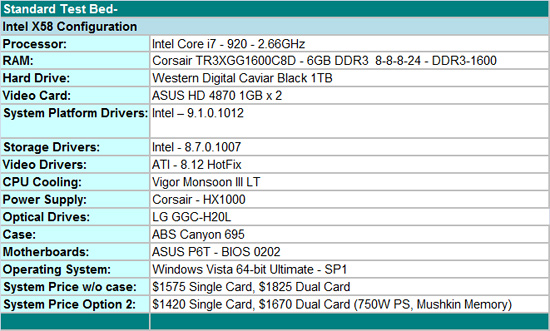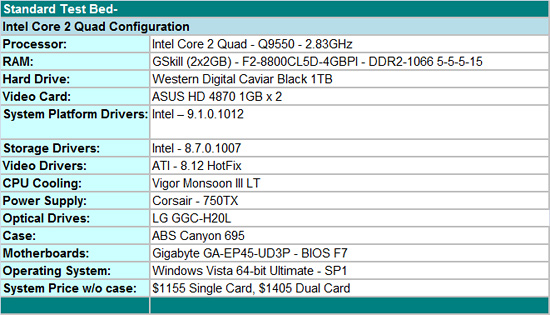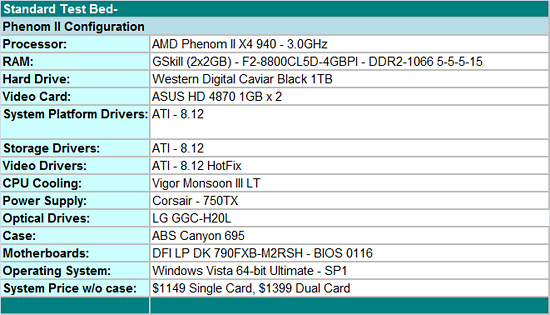CrossFireX and the Phenom II X4 940 – Competitive or Not?
by Gary Key on February 2, 2009 12:00 AM EST- Posted in
- Motherboards
Test Setup
Fortunately for us, during motherboard testing we test SLI or CrossFireX solutions extensively. However, we do not test the graphics cards in the same manner as we do in a GPU review. During motherboard testing, we focus on ensuring compatibility, identifying any layout problems, and checking performance deltas between motherboard chipsets. Instead of running absolute GPU intensive settings, we seek a balance between playable settings, quality, and platform performance. This means reasonable resolutions and 2xAA/8xAF settings to keep the GPU from being a limiting factor where possible. We think these quality settings are fine for most users, especially in FPS games where the differences between 2xAA, 4xAA, or 8xAA are minimized due to the speed of the game.
We run our benchmarks at two of the most popular resolutions for new systems, which happen to be 1680x1050 and 1920x1200. We mention this now as our overview of CrossFireX performance will not have 2560x1600 at 4xAA/16xAF results or tri-card setups. The population of 30” monitors is rather small and except for Crysis, tri-card performance is generally worse than dual card performance with our midrange setups. Consider this review a snapshot of CrossFireX performance with one particular GPU selection as we will not be looking at other ATI cards except the HD4870 1GB.
As such, our test systems today are platform oriented based on similar components and overall pricing schemes between the Intel Core 2 Quad and AMD Phenom II platforms. We selected a “budget” Core i7 setup that is capable of both SLI and CrossFire to ensure platform consistency when we look at SLI performance shortly.



Our Phenom II and Intel Core 2 Quad platforms are within $6 of each other. We fully realize the pricing of the Phenom II X4 940 competes with the Intel Core 2 Quad Q9400, not Q9550, but we are looking at platform costs here. Of course, we could debate the various component choices for several pages and yes, the platform costs could shrink on either side. We did not use rebates in our pricing and all costs were gathered from Newegg on 1/29/09. We think our selections offer the best blend of price, performance, compatibility, and quality right now.
Our decision to go with a 790FX/SB750 combination on the AMD side is strictly based upon performance. The 790FX is about 3%~5% faster on average than comparable 790GX products. AMD continues to recommend the 790GX/SB750 as the platform of choice for the AM2+ and upcoming AM3 products. We disagree from a performance viewpoint; the 790FX/SB750 combination is simply the best choice in our opinion. Of course you will typically pay about $35~$40 or greater for the 790FX boards, but if you intend on running CrossFireX, we think it is worth the additional cost.
On the Intel side, we decided to go with the P45 chipset as it offers a very balanced blend of performance and value. The Gigabyte GA-EP45-UD3P is a superb CrossFire capable motherboard that also happens to be one of the best overclocking S775 products around. The P45 offers dual PCI Express x8 operation in CrossFire mode compared to dual x16 on the 790FX, X48, and X58 boards. However, we did not notice any performance differences between dual x8 and dual x16 operation when comparing the P45 to the X48 in offline testing utilizing our resolutions and quality settings.
The i7 setup can be cost reduced and we did offer a cost improved option by switching out the power supply and memory for equal alternatives. If you are only interested in CrossFire capability on the i7, the motherboard cost can be reduced another $45 and if memory overclocking over DDR3-1800 is not important, then memory costs (DDR3-1600 6GB HP kits) can be reduced another $40 on average. This would bring the i7 platform cost down to $1335 for a single video card configuration without too much of a problem.
Our standard power consumption results with the i7 boards utilized the Corsair HX-1000 power supply and our P45/790FX boards used the Corsair 750W power supply. We are qualifying the Corsair 750TX (and other under 1000W units) on the i7 platform currently. However, we did complete our benchmark runs today on the i7 with the Corsair 750TX. We will provide additional power consumption and temperature results based on these changes shortly.
We selected the ASUS EAH4870 DK/HTDI/1GD5 video card. It is a non-reference design that offers improved thermals and acoustics over the standard HD4870 1GB cards on our board choices. We think if a user is going to run CrossFireX on one of these platforms, then the best possible performance choice is the HD4870 1GB. Depending upon pricing on the HD 4870 1GB cards, a 4870X2 might be a better choice for most users.
The WD Caviar Black 1TB is our hard drive of choice for storage purposes. LG’s Blu-ray playback capable drive fills in for optical duties. We purchased two of G.Skill's impressive DDR2-1100 4GB kits that operate at speeds up to DDR2-1240 on our boards with about 2.1V of VDimm. We used 4GB in our Phenom II and Core 2 Quad systems with memory set at DDR2-1066 with 5-5-5-15 timings at 1.8V. Our DDR3-1600 6GB kit is from Corsair and was dialed in at DDR3-1600 with 8-8-8-24 1T timings at 1.60V. Vigor provided their Monsoon III LT CPU cooler that offers mounting kits for the 1366, 775, and AM2+ processors. ABS provided their Canyon 695 case and it has proved to be exemplary during testing.
Our game selections are a few of the recent top selling titles. Certain titles that are capped at 30FPS like Command and Conquer Red Alert 3 or do not benefit from CrossFireX (Flight Simulator X) were not included. We tested Grand Theft Auto IV with the latest 1.02 patch but still have a couple of unanswered anomalies on the i7 platform. Those results are not available today.
We are also including results with our processors overclocked for CrossFire only. Overclock results with a single card configuration provided little benefit in most cases. Simply overclocking the video cards resulted in better performance numbers than overclocking the processors with this configuration. That is a story for another time. The Phenom II 940 is running at 3.95GHz (17.5x226, DDR2-1205, 5-5-5-18, NB Speed 2486Mhz ), Core 2 Quad Q9550 at 4.25GHz (8.5x500, DDR2-1000, 5-4-4-12), and the Core i7 920 at 4GHz (20x200, DDR3-1600, 8-8-8-24). These were the maximum stable overclocks on air-cooling that we could sustain in a 24/7 setup with Vista Ultimate 64 SP1.










68 Comments
View All Comments
megabuster - Monday, February 2, 2009 - link
If it's not too troublesome next time please include a few pictures of your hardware set up. :)none12345 - Monday, February 2, 2009 - link
There are errors in the benchmark charts on page 9....and maybe other pages..In the first chart you have the overclocked 9550 CF at the top of the chart, yet if you look at the min and max frame rates it is NOT the top performer, the core i7 beats it with 5 more min frames and 12 more max frames. The overclocked phenom ii cf shoudl also beat it with 11 higher min frames tho 13 less max frames.
In the second chart, the clear winer by the min/max frames is the overclocked phenom ii CF, it had a 9 higher min fps and 6 higher max fps yet its rated lower then the core i7. It had 21 more min fps yet only 2 less max fps then the 9550 but was ranked way lower.
Your score or min/max numbers are fubar...something is really wrong with those charts.
Maybe some of the other charts are messed up too, but this page stood out like a sore thumb.
Gary Key - Monday, February 2, 2009 - link
The charts are sorted by Average Frame Rates, unfortunately our engine does not allow multiple sorts on values. Let me see if I can do something different in the SLI article with an Excel chart, or I might just separate all the values into individual charts..7Enigma - Tuesday, February 3, 2009 - link
Gary, Let me just throw my opinion in to keep it sorted by average frame rates.That is probably the most important data point (next to possibly minimum) and so is a good way of ranking. I will thank you again and ask that all future reviews use your format of showing all 3 data points as it is very important in determining the better card for a specific game at a specific resolution/detail setting.
balancedthinking - Monday, February 2, 2009 - link
The Phenom II massively gains gaming performance with an overclocked Nortbridge because it directly boosts the cache performance.Reviews like the one from the german site p3d showed an increase in gaming performance worth 300-500mhz core frequency for an overclock of only 400 mhz NB frequenzy!
The NB runs stock @ only 1800 mhz. Good overclocks are in the range of 2600 - 2800mhz. Imagine the performance that is missing in the OC results from anand!
That is why the Q9550 can pull ahead when overclocked, because due to architecture, the cache gets overclocked too wenn you raise the reference clock.
The Phenom II 940 offers great potential when tweaking the NB clock but you have to do it manually in contrast to Q9550!
So please Anand, redo the Phenom II 940 OC tests with the Northbridge frequency maxed out. Only that would be a fair comparison.
Gary Key - Monday, February 2, 2009 - link
The NB frequency is at 2486MHz in these tests. I have it listed on page two now. I could not go higher and maintain this clock speed in Vista 64. Raising the NB speed to 2712 meant lowering CPU speed to 3842MHz. I test both values and our 3955/2486 combo performed the best.Kiijibari - Monday, February 2, 2009 - link
Perfect :)Thx a lot.
Kiijibari - Monday, February 2, 2009 - link
I agree, an info concerning the NB clock of the Phenom2 is missing.@anandtech: Please add it.
cheers
Kiiji
Kiijibari - Monday, February 2, 2009 - link
From the article:"(17.5x226, DDR2-1205, 5-5-5-18)"
That means, that the NB was clocked with 2034 MHz, if nobody changed the default multiplier 9
CPUGuy - Monday, February 2, 2009 - link
balancedthinking,Thanks for providing this tidbit of information regarding how cache is overclocked on the Intel vs AMD CPUS. If this review is based on what you said then it should be amended for re-testing.